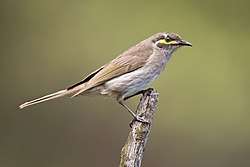Caligavis
Caligavis is a genus of honeyeaters endemic to New Guinea and Australia. It includes former members of Lichenostomus, and was created after a molecular phylogenetic analysis published in 2011 showed that the original genus was polyphyletic.[1]
| Caligavis | |
|---|---|
 | |
| Caligavis chrysops (yellow-faced honeyeater) | |
| Scientific classification | |
| Kingdom: | Animalia |
| Phylum: | Chordata |
| Class: | Aves |
| Order: | Passeriformes |
| Family: | Meliphagidae |
| Genus: | Caligavis Iredale, 1956 |
Species
The genus contains three species:[2]
| Image | Scientific name | Common Name | Distribution |
|---|---|---|---|
 | C. chrysops | Yellow-faced honeyeater | south, east Australia |
| C. subfrenata | Black-throated honeyeater | New Guinea | |
| C. obscura | Obscure honeyeater | New Guinea | |
The name Caligavis was first proposed by the English-born ornithologist Tom Iredale in 1956.[3][4] The word is derived from the Latin caligo meaning obscurity and avis bird.[5]
References
- Nyári, Á.S.; Joseph, L. (2011). "Systematic dismantlement of Lichenostomus improves the basis for understanding relationships within the honeyeaters (Meliphagidae) and historical development of Australo–Papuan bird communities". Emu. 111: 202–211. doi:10.1071/mu10047.
- Gill, Frank; Donsker, David (eds.). "Honeyeaters". World Bird List Version 6.1. International Ornithologists' Union. Retrieved 28 January 2016.
- Iredale, Tom (1956). Birds of New Guinea, Volume 2. Melbourne: Georgian House. p. 150. OCLC 54363570.
- Salomonsen, F. (1967). "Family Maliphagidae, Honeyeaters". In Paynter, R.A. Jnr. (ed.). Check-list of birds of the world (Volume 12). Cambridge, Mass.: Museum of Comparative Zoology. p. 366.
- Jobling, James A (2010). The Helm Dictionary of Scientific Bird Names. London: Christopher Helm. p. 84. ISBN 978-1-4081-2501-4.
This article is issued from Wikipedia. The text is licensed under Creative Commons - Attribution - Sharealike. Additional terms may apply for the media files.